Summary: Managing distributed agile teams is challenging. But with the proper guidance, you can ensure productivity while working with a distributed team. This guide is a detailed insight into what distributed teams are, whether they can co-exist with Agile teams, and how to make distributed agile teams work.
Distributed and agile software development is a widely used practice in the modern-day Software Development world. Though their meaning is pretty clear when used differently, using them together as “Distributed Agile Teams or Methodology” is a new concept for many.
While agile product development solutions emphasize teamwork and collaboration from a physical co-location, distributed team members work from different world corners. Thus, applying agile principles in a distributed environment brings a lot of challenges.
However, using suitable approaches, distributed teams can tackle these challenges effectively.
Over time, Net Solutions’ agile processes have matured, and that has helped us consistently deliver excellent quality work remotely for thousands of customers globally. Therefore, this article will focus on how remote teams can use the agile approach to its full capacity.

We respect your privacy. Your information is safe.
What is Agile Development?
Agile is a culture, not a collection of guidelines or rules. In software development, agile methodology revolves around discovering requirements, developing robust solutions, and continuous delivery through team collaboration and communication.
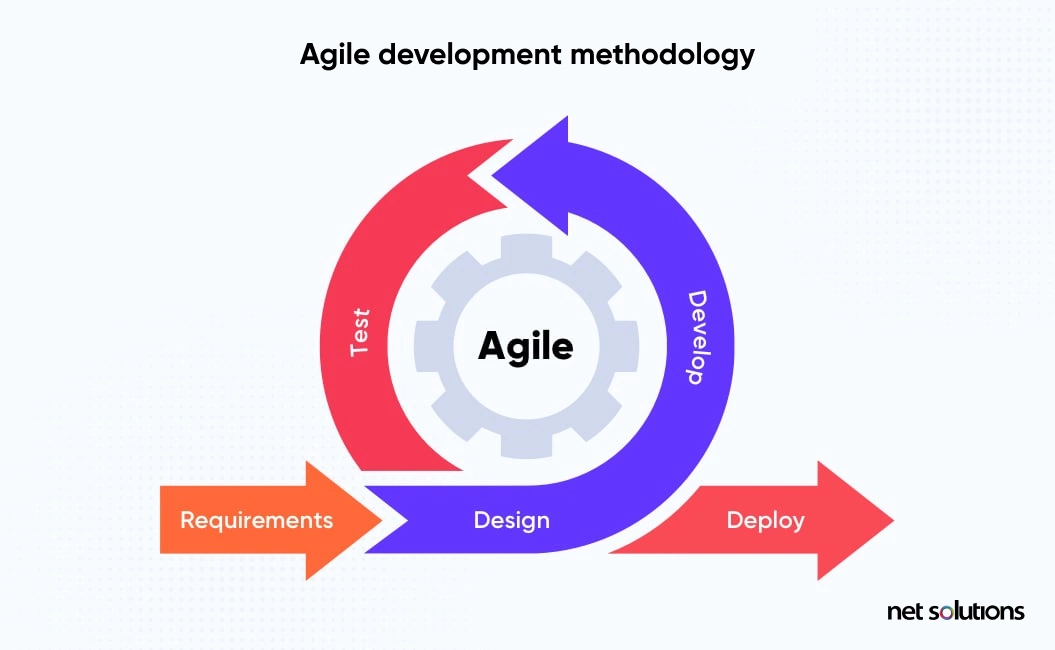
Agile practices prefer individuals and interactions over processes and tools, customer collaboration over contract negotiation, responding to changes over making plans, and working software over detailed documentation.
The Benefits of Agile
Here are some benefits of using agile for software development:
- Improved Quality: Using agile, the team focuses on high-quality development, dividing the project into small sprints. Agile development teams create high-performing solutions by producing continuous builds and testing during each iteration.
- Predictable Delivery: In agile, with fixed schedule sprints, product features are delivered frequently, letting teams beta test everything before the first release of the product. It improves product quality as well as business value.
- Transparency: Using agile development methodology, clients can stay involved in product development. From prioritizing features to reviewing sessions and sprint planning – everything stays under their control, and they see the work in progress. That means no surprises later in the product launch cycle.
What is a Distributed Team?
Distributed development involves planning, building, and testing software with decentralized teams across different physical locations. The distributed software development team members can work on projects from any location using internet-based communication and collaboration tools.
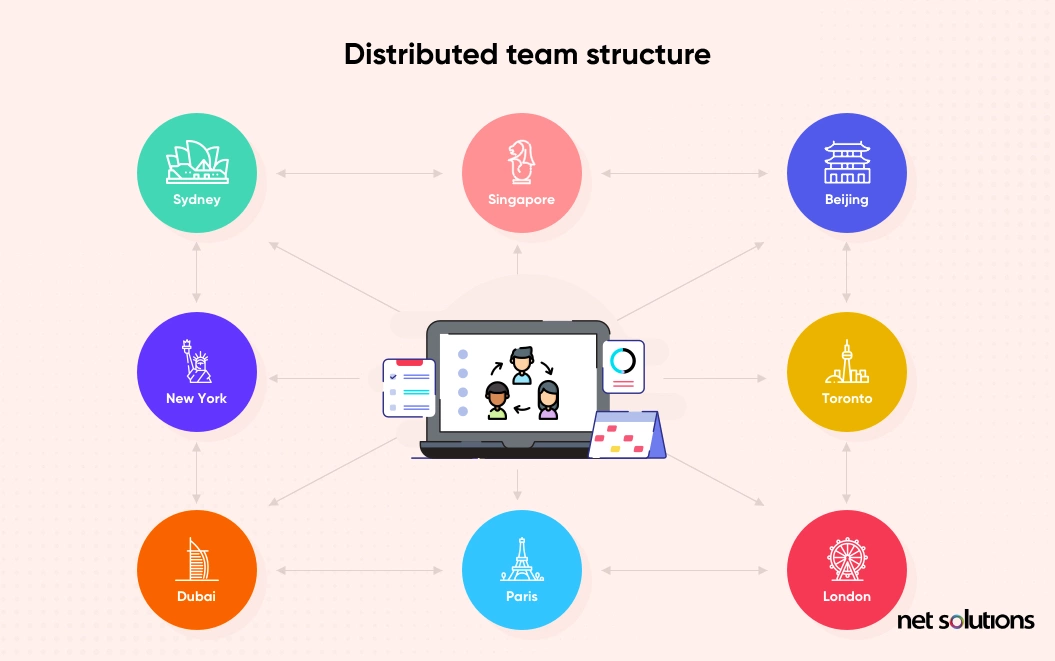
The Benefits of Distributed Teams
Some of the benefits of creating distributed teams include the following:
- Accessible Talent: Building a distributed software development team lets you cross physical boundaries when hiring talent. You can consider hiring talent from anywhere worldwide to bring diverse talent together.
- Cost-Effective: The rates and salaries of developers vary according to their geographical areas. For example, a software developer’s average salary is around $100,000 in counties like the USA and UK. However, in many other countries, you can hire competent Agile developers with an annual salary of less than $30,000.
- Increased Productivity: In a distributed working environment, the chances of losing a valuable team member are significantly less due to several reasons. Many studies show that employees working in a distributed environment perform better, take fewer sick leaves, and get the work done faster – a win-win for all.
Can Agile and Distributed Teams Co-exist?
As seen, agile and distributed teams don’t merge well. While agile says development teams must work together daily throughout the software development process, there is no such possibility in a distributed environment.
On the one hand, while agile prioritizes face-to-face meetings (for scrums, sprint planning, and backlog grooming), distributed team members might never meet each other.
Now, how can they co-exist?
Of course, they can. The world-famous agile methodology allows applying its principles to teams working remotely. The only key is not following each point of the agile manifesto and focusing on minimizing the consequences of working remotely effectively.
Let’s now see how teams can implement agile in a distributed environment:
8 Key Strategies to Make Distributed Agile Teams Work
While Distributed Software Development provides advantages like access to the global market, talent, and reduced costs, it can also restrain communication within the team.
However, with the rise in remote work growth, businesses are only left with one option — limiting its consequences and managing teams the agile way for better productivity and time management.
Here are a few techniques that can help you manage distributed agile teams effectively:
1. Ensure proper visibility of your project status
One of the biggest challenges with distributed teams working the agile way is the lack of visibility about project status. However, in the agile world, where project requirements change frequently, project status visibility is a factor you must maintain.
As a project manager/owner of a distributed agile team, you must ensure your project status reports are uploaded and clear before starting a new sprint cycle.
It is the only way to capture the full efforts of a sprint and know where the project stands at the moment. PMs usually experience problems when fetching out the correct status of the project. Though this is also a problem with collocated teams, in a distributed environment, it enhances further.
However, distributed agile teams can use agile project management tools like JIRA to monitor project progress and ensure better status visibility.
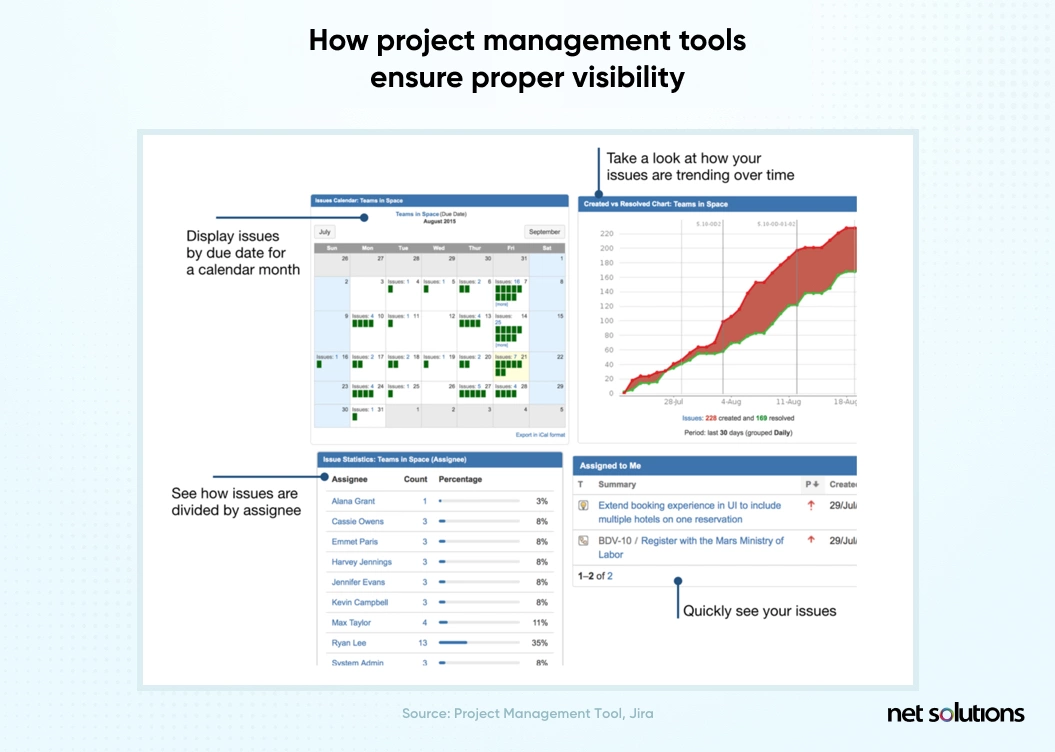
2. Measure your team’s productivity
In the end, it is productivity that matters. By measuring your distributed agile team’s productivity, you can visualize who is working on what task and what needs to be changed to make the processes more efficient.
Here are a few agile metrics that you must use to measure the productivity of your distributed agile teams:
Velocity: It measures the team’s average story points over the last sprint cycles. Using a velocity report, you can measure the amount of work your team can handle in upcoming sprints.
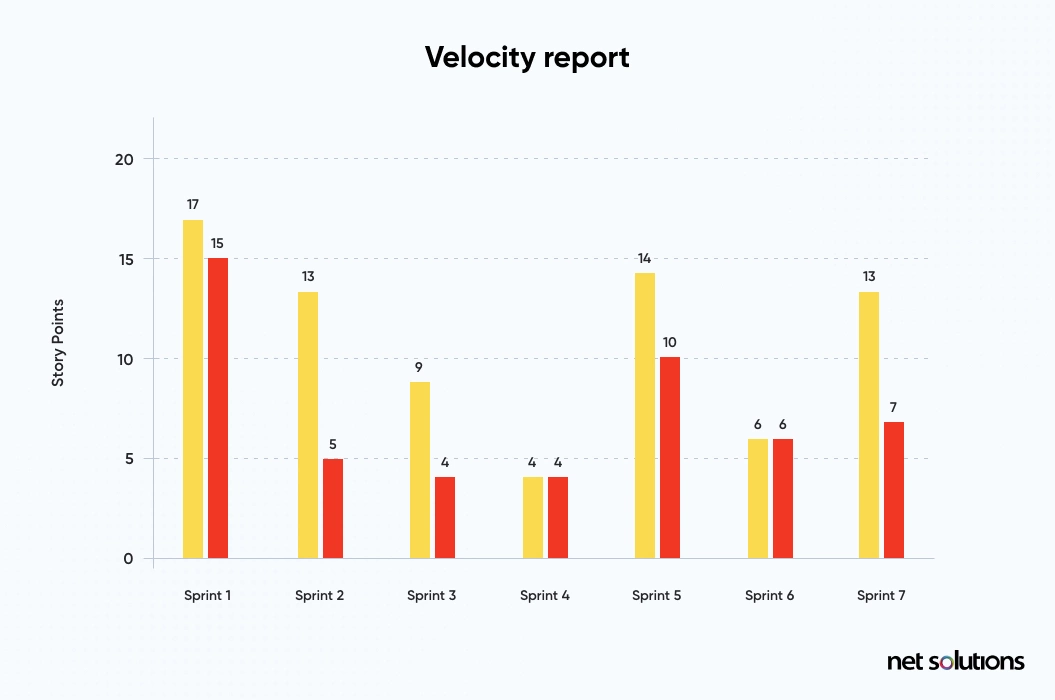
Sprint Burndown: It updates how many story points your team has completed in a given sprint. Sprint burndown is the best way to stay updated about the status of your project.
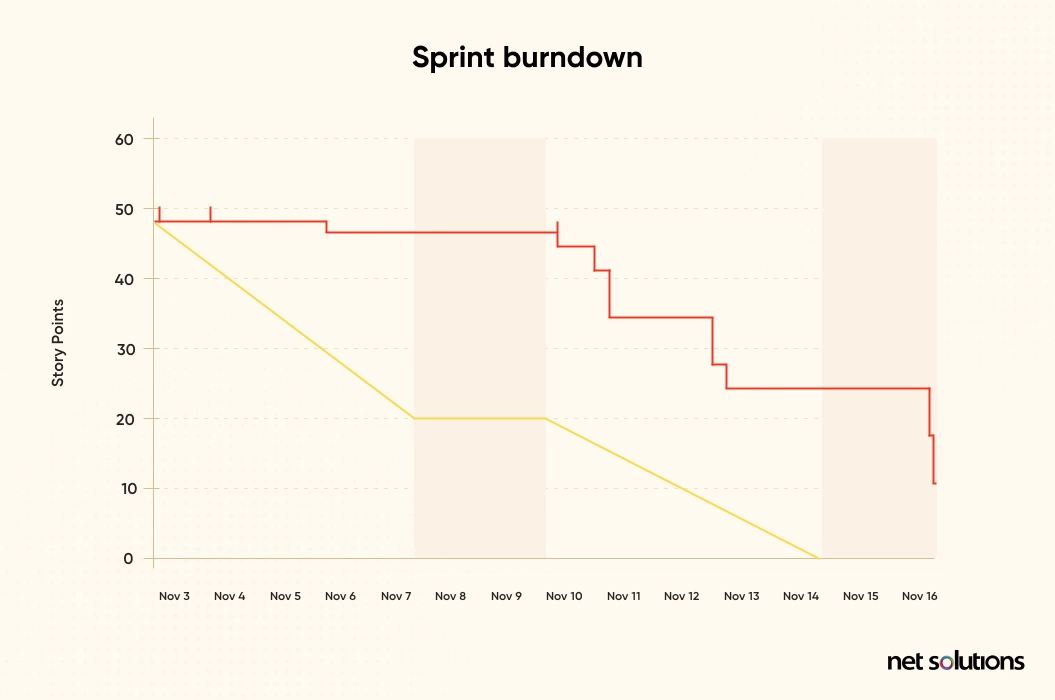
Cumulative Flow Diagram: With CFD, you can monitor project progress, and user story changes amid different statuses – in progress, review, or completed. The curve in CFD should be smooth, as a jagged one indicates unproductive resources and bottlenecks.
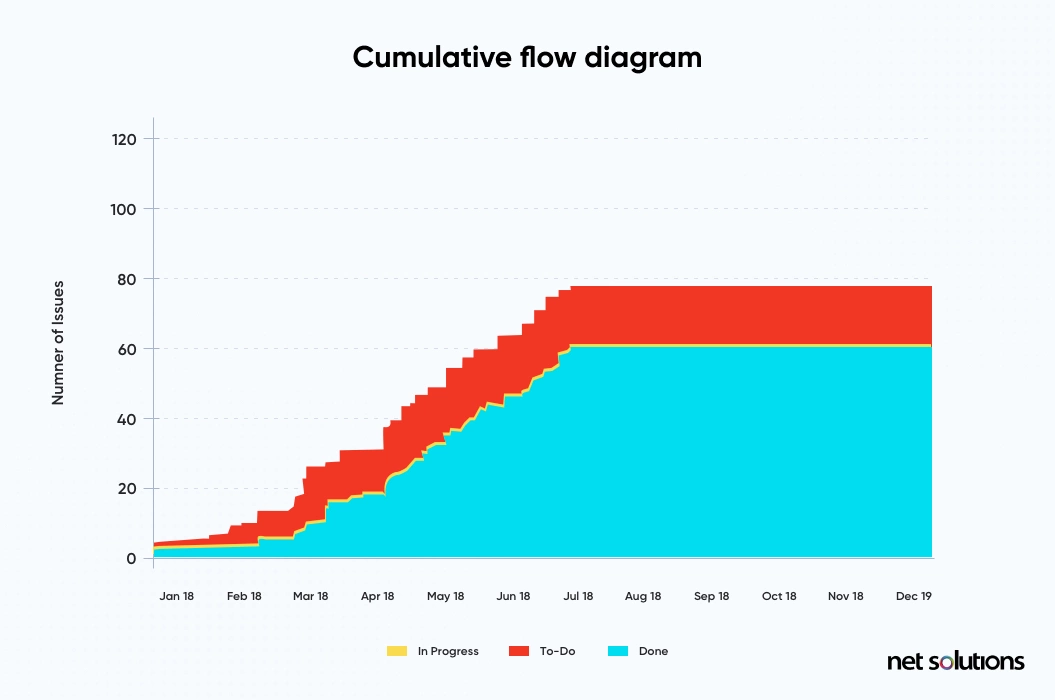
3. Invest in tools for better communication & collaboration
One of the most essential distributed agile principles is effective communication and collaboration. You can only achieve shared ownership and common purpose by adequately fostering agile values among teams, primarily when they work in different time zones.
The whole point of agile is to allow teams to respond quickly to change, all of which is made possible only through consistent and effective communication. Daily stand-ups, planning sessions, and sprints are ways teams keep communicating and collaborating.
To make distributed teams work agile, project owners must ensure proper collaboration between team members by organizing daily scrums, planning sessions, and discussing virtually.
Several mobile applications and tools online can help you set up effective communication practices. Selecting the right tools depends on team size, project complexity, and requirements. Some of the most used tools by agile teams for communication and collaboration include:

4. Distribute work among team members
There’s a method to this madness. You have to allocate work to different teams based on your location model. If your teams sit in one office, you’re already doing what you must.
But if you’re partially or fully remote, you need to allocate work based on the local and in-house expertise within those teams.
Let’s assume you hire a remote agency to outsource all your design & development work but have in-house scrum masters and product owners. This scenario can allow you to plan and strategize closely with the in-house team and let the remote team members execute.
Or, you can hire a remote agency for end-to-end digital transformation solutions. The scrum masters, product owners, and other resources are theirs to handle, including the strategy, planning, and execution.
Also, you must distribute the workload evenly among the members of your distributed agile teams because an uneven workload can cause several problems in a distributed environment, including delays in delivery, frustrated or less motivated resources, and many others.
Therefore, treat all members equally and don’t forget to show them respect.
5. Keep a check on code quality
At times, distributed agile team leaders may need help to measure code quality and project health. The status of unit test cases, build stability, coverage rates, etc., may only be revealed to them once the team takes the time to communicate with them over a call or a message.
In such situations, the product’s quality suffers the most. Sometimes, suppose teams didn’t ensure build stability might stop the entire team’s work.
For example, suppose team A in country A checked in a code that broke the build and went home without noticing. It will stop the working of teams B, C, D, and so on in different countries. Therefore, you must monitor project health and code stability when working in a distributed environment.
Here are three distributed agile best practices using which you can bridge this gap:
- Use continuous integration tools that provide build automation and continuous tracking of project quality.
- Implement Pair Programming to help the teams improve code quality and speed up the development process.
- Ensure your quality assurance team is active and reporting unit testing bugs immediately.
6. Nurture your agility
Since agility is an attitude you inculcate within yourself and your teams, it needs continuous nurturing.
Every new product can present a new set of problems that you cannot solve the same way over and over again. For teams to be able to adapt to such a frequency of changes, agile has to be baked into their very core.
That’s one reason companies hire and work with experienced agile coaches.
Another method of nurturing your team’s agile processes is collaborating with remote teams outside your organization. This way, your teams learn how other distributed agile teams work remotely, which is an excellent source of learning.
Collaborative work is not just limited to agile. It also extends to design.
“Agile is iterative. Design in iterative. Why couldn’t they work together?”– Jeff Gothelf
7. Outsourcing agile teams
It would help if you went for Agile transformation with an experienced agile team. To build an agile team, you must spend a considerable fortune on hiring, inductions, training, etc. You have to worry about everything.
Even after that, there’s no guarantee that you’ll have your perfect team. That’s one of the pitfalls of running the show yourself. Before you know it, you’re doing everything but creating what you set out to build.
Outsourcing makes it easier to manage your resources. With fewer people to manage, you can think more about improving what you’re building. On top of that, an experienced agile remote team adds more value to your team because of their extensive prior work.
Outsourcing helps bridge significant skill gaps and manage costs that can otherwise skyrocket.
8. Foster a sense of community
United, you stand firm, but alone you crumble like a house of cards. What it means is that it’s essential for your team members to feel connected and supported, especially if they’re working from different locations. Encourage them to work together and share knowledge. It would keep them connected and foster a sense of community that wants to grow together.
You can encourage collaboration and foster a sense of community in your team through virtual team-building activities and collaborative practices like pair programming and code reviews.
9 Agile Tools For Managing Distributed Teams In 2023
Remote work is the present and future of the software development world. However, managing remote teams can be tricky – you will need everything from communication tools to roadmaps and Gantt charts. How to manage distributed teams in agile? Here are the ten best agile project management tools that can make managing remote and distributed teams a little easy for you:
1. Jira
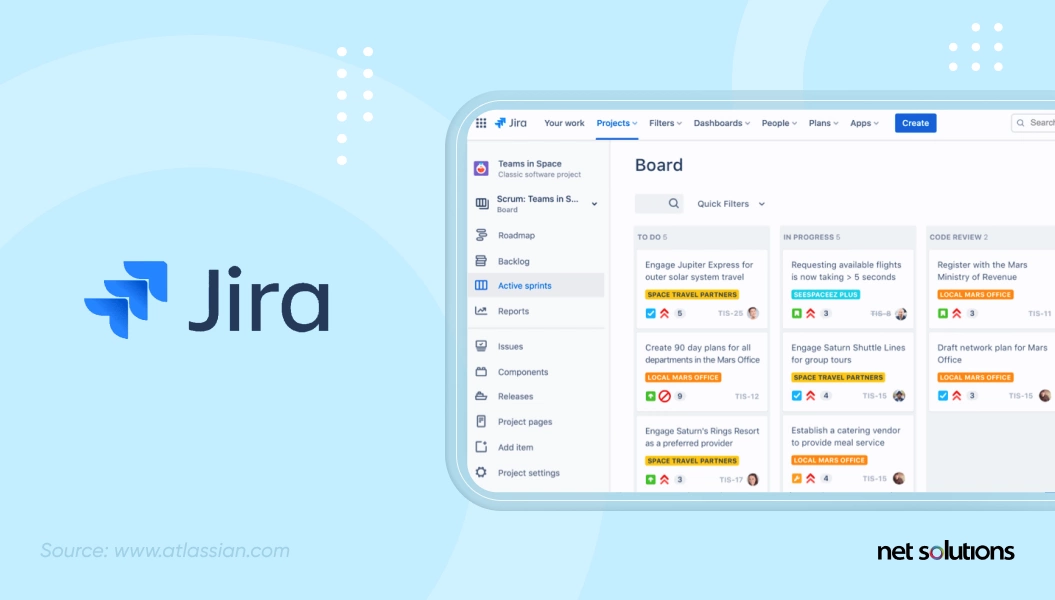
Jira is a top-rated and easy-to-use tool for agile project management needs. A distributed agile team can use it to plan, manage, and track everything a software development project demands.
With Jira, you can personalize your workflow, and with effective team collaboration, it is easy to release quality software on time. Here are the key features of Jira that make it worth considering:
- Custom fields
- Customizable Scrum Boards
- Customizable Kanban sheets
- Tool integration
- Bug tracking
Real-time project status tracking with sprint reports, burnout charts, velocity charts, and flow diagrams.
2. GitLab
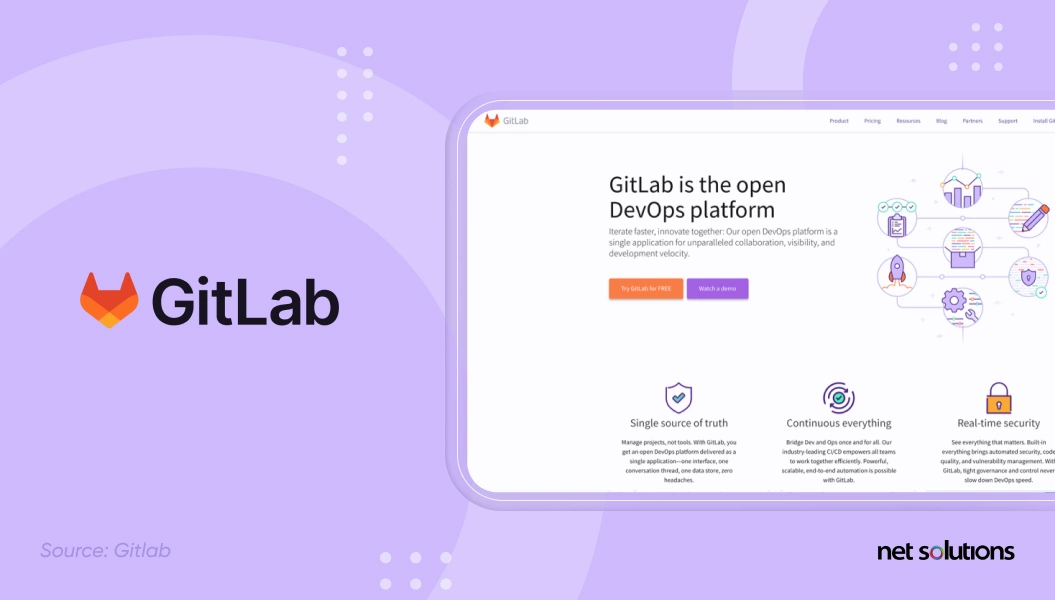
It is a cloud-based DevOps tool that helps organizations improve operations and is a mainstream tool utilized in agile project management.
By helping with fast-track software delivery, it helps distributed agile teams reduce cost as well as risks associated with product vulnerabilities while at the same time increasing developers’ productivity. Here are the key features of Gitlab that can help distributed agile teams work efficiently:
- Kanban boards
- Workflow management
- Several collaborative tools
- Portfolio management
- Analytics and reporting feature
3. GitHub
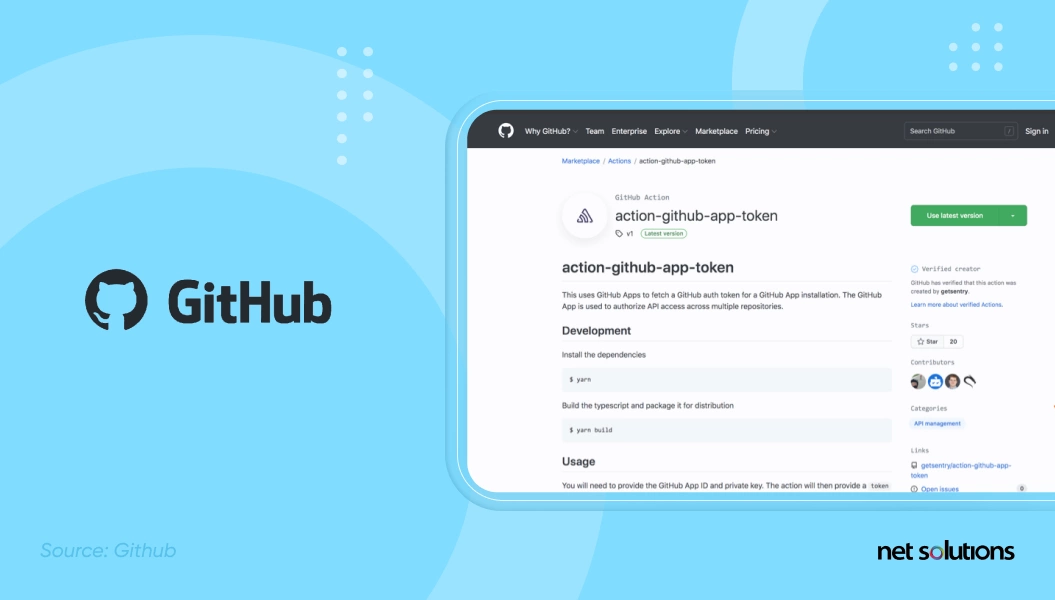
GitHub is considered one of the most popular agile project management tools used and loved by millions of developers worldwide. It is the world’s largest development platform with unique features like CI/CD, advanced coding, and security.
Automating features like testing, CI/CD, project management, onboarding, and planning lets distributed agile teams eliminate overheads. Its out-of-the-box security features include private repositories, two-factor authentication, and GPG commit signing verification.
Some other key features of GitHub that make it more exciting include:
- Team management
- Codespaces
- Project management
- Collaborative coding
- Enterprise security
- Product roadmap
- Notifications
4. Trello
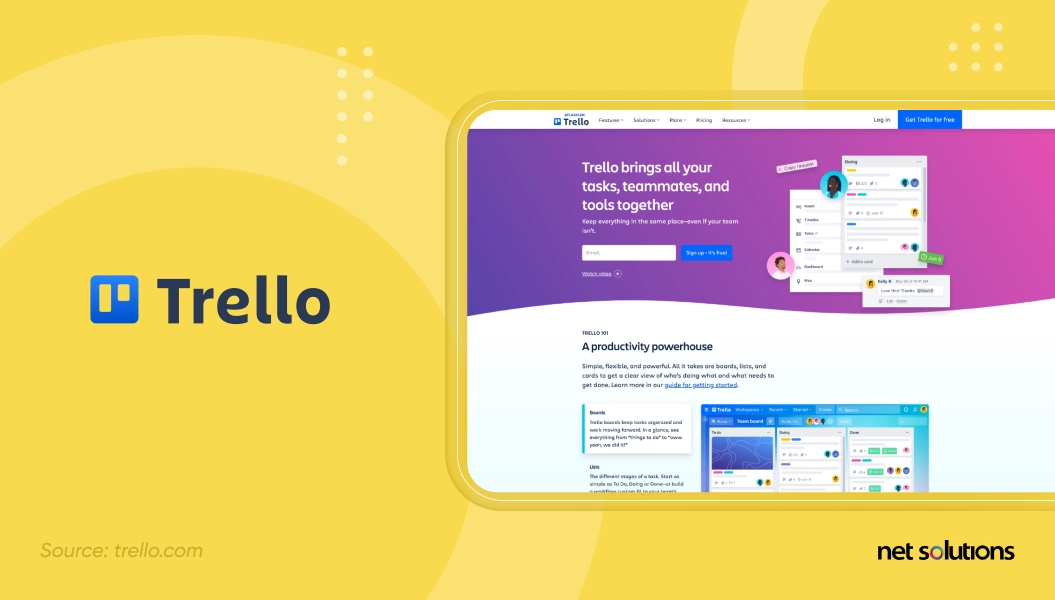
Trello is another agile project management tool on which you can create and manage tasks as a team. It uses the Kanban board concept, where you can create cards representing tasks, and your team members can move them through different stages of completion. You can use this tool for many applications, from becoming more productive to managing tasks among distributed teams.
Here are some key features of Trello:
- Trello has options to customize your boards and tasks with labels, checklists, attachments, and due dates.
- You can integrate Trello with tools like Google Drive, Slack, and GitHub.
- Trello lets you collaborate with other team members by leaving comments and uploading files on cards.
- The visual interface of Trello is user-friendly. You can easily see your work progress and communicate with team members.
- Trello offers several security features to help keep your data safe, including secure socket layer (SSL) encryption, two-factor authentication, and access controls.
5. Asana
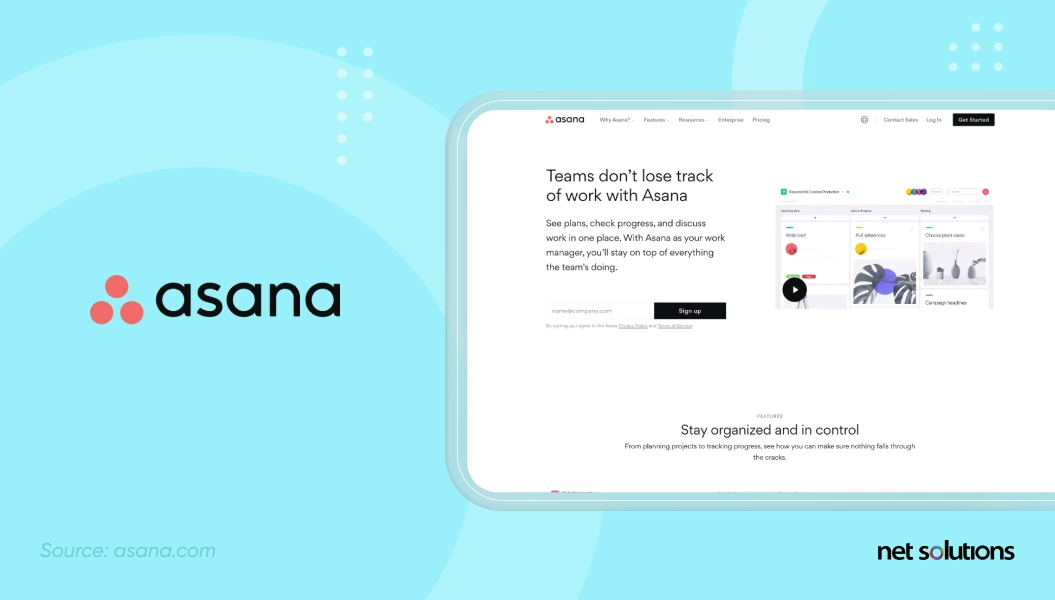
Asana is a project management and organization tool on which you create tasks, assign them to team members, and track progress. You can also use Asana to manage project timelines, set deadlines, and communicate with your team.
Asana offers several features to help you and your team stay organized and on track, such as:
- Task management feature to allow you to create tasks, assign them to team members, and track progress. You can also set deadlines, add attachments, and leave comments on assignments.
- Asana offers a range of tools to help you manage your projects, including a calendar view, Gantt chart view, and kanban-style boards.
- The project management tool has features to help teams collaborate, such as @mentions, assigning tasks to multiple team members, and leaving comments on tasks.
- You can integrate Asana with several other tools, such as Google Calendar, Slack, and Dropbox, to help you manage your workflow more efficiently.
- Asana offers security measures to keep your data safe, including SSL encryption and the option to enable two-factor authentication.
6. Slack
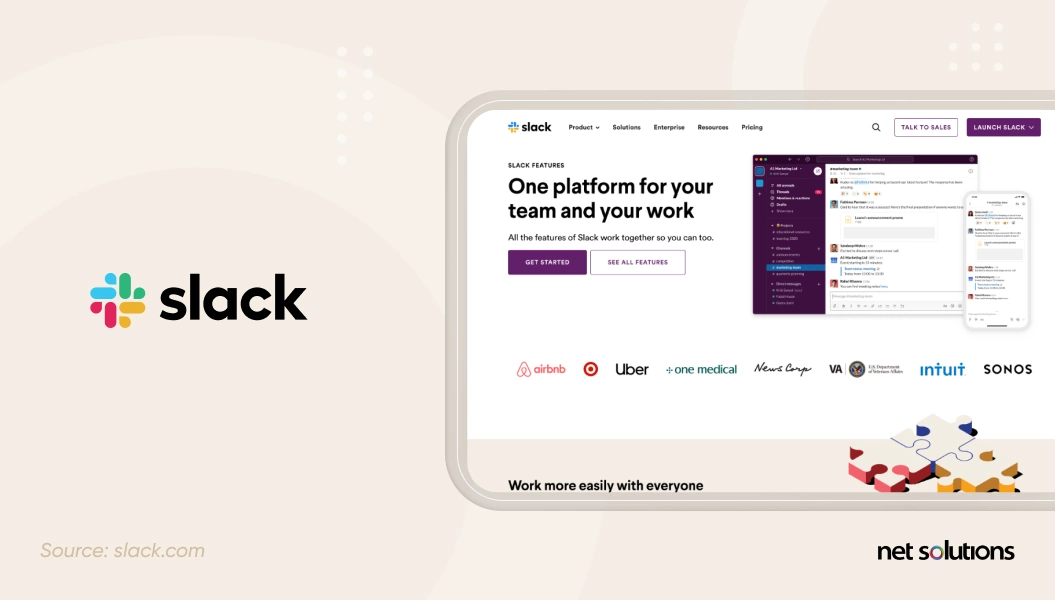
Slack is a real-time communication and collaboration platform that replaces email and other messaging apps as primary team communication tools. You can use it for both personal contact and managing communication among distributed teams.
Slack offers the following features to help teams communicate and collaborate more effectively:
- Slack lets you create channels for different projects, teams, or topics to keep communication organized and focused.
- You can send direct messages to individual team members or small groups with Slack.
- You can integrate Slack with many tools, like Google Drive, Trello, and Asana, to help you manage your workflow more efficiently.
- With Slack, you can share files, including documents, images, and videos, with your team.
- You can communicate with your team members on the go using the Slack mobile app.
- Slack enables security measures like SSL encryption and two-factor authentication to ensure your messages don’t fall into the wrong hands.
7. ClickUp
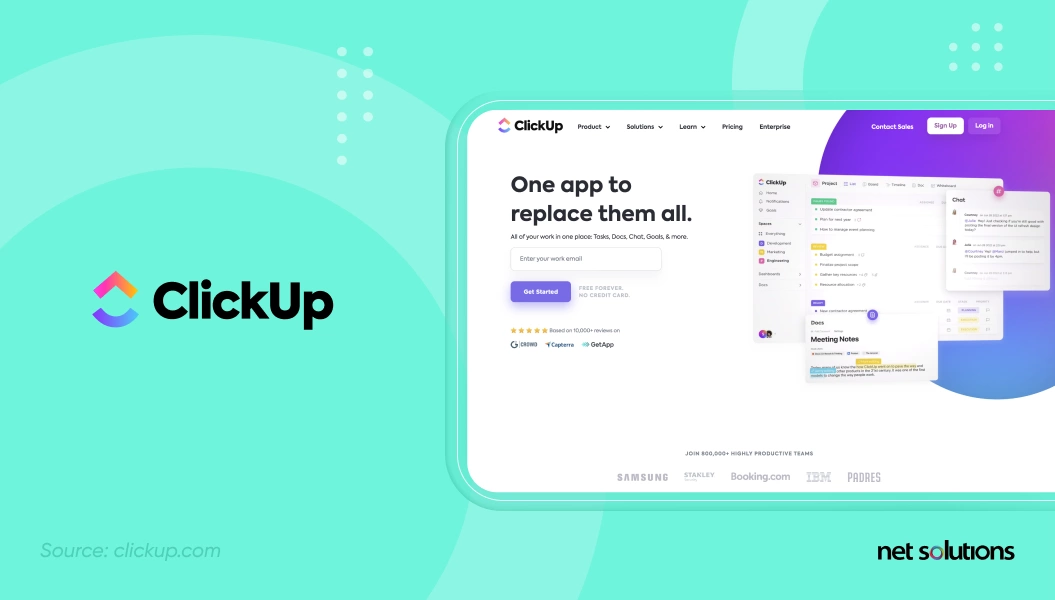
ClickUp is a project management and productivity platform on which teams can organize, track, and collaborate on tasks and projects. It is user-friendly, customizable, and offers a range of features to help teams work more efficiently and effectively.
Here are some impressive features that Clickup offers:
- Task and project management features for creating and assigning tasks, setting deadlines, and tracking progress. You can also create and manage projects and organize tasks into lists and folders.
- You can communicate through chat, comments, and @mentions. Clickup also has a “watercooler” feature for casual conversations.
- Clickup offers a timer for tracking the time spent on tasks and projects. You can also create time estimates for each task.
- Collaboration features like the ability to assign tasks to team members, add attachments and comments to tasks and set up task dependencies.
- You can integrate Clickup with tools like Google Drive, Slack, and Trello to maximize productivity.
- It is possible to customize Clickup to fit your team’s specific needs through custom fields, tags, and views.
8. Google Workspace

Google Workspace is a suite of productivity and collaboration tools developed by Google to help businesses and organizations communicate and collaborate efficiently. It includes the following tools:
- Gmail: A professional email service that includes spam protection, email search, and email delegation.
- Google Drive: A file storage and synchronization service that allows users to store and access files from any device.
- Google Docs: A word processing application that allows users to create and edit documents online.
- Google Sheets: A spreadsheet application that allows users to create and edit spreadsheets online.
- Google Slides: A presentation application that allows users to create and edit slide presentations online.
- Google Calendar: A calendar application that allows users to schedule events and appointments and share calendars with others.
- Google Hangouts: A communication platform that includes video conferencing, voice calls, and messaging.
- Google Keep: A note-taking application that allows users to create notes, lists, and to-do lists.
- Google Forms: A survey and data collection tool that allows users to create and distribute forms to collect responses.
- Google Sites: A website creation and hosting platform that allows users to create professional-looking websites.
Google Workspace is available in various plans, including a free version for personal use and paid versions for businesses.
9. Basecamp

Basecamp is a project management and team communication for helping teams organize, communicate, and collaborate on projects in a single, centralized location. It includes the following features:
- Ability to create and assign tasks to team members, set deadlines, and track progress.
- Scheduling features to help users create and manage project schedules and calendars.
- A centralized location for storing and organizing project files.
- Messaging features to let businesses communicate with team members through real-time chat or message boards.
- Document collaboration feature to help team members work together on documents in real time and track changes.
- Ability to track the time they spend on tasks and projects.
- Basecamp allows integration with other business tools, such as Google Calendar and Slack.
Basecamp is available as a web-based and mobile app for iOS and Android.
Frequently Asked Questions
Yes, agile can work in distributed locations. But you must use additional tools and practices to facilitate communication and collaboration among team members.
Leading a distributed team is challenging and requires a different approach than leading a co-located team. Here are a few tips that can help:
- Establish clear goals and expectations to ensure every team member knows how they fit into the team’s vision.
- Use communication tools like Slack and Microsoft teams to ensure every team member is on the same page.
- Use social media and virtual water coolers to build relationships.
- Be open to different working styles and approaches.
While the best communication method choice depends on the team’s needs, some communication methods that remain universal are emails, chat, voice calls, video conferencing, and project management software.
Communication and collaboration, Time zone differences, Cultural differences, and dependence on technology are some agile challenges that distributed teams face.




